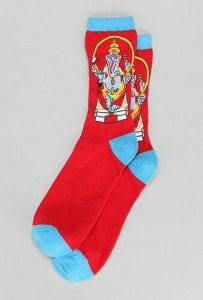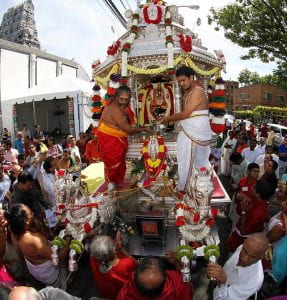Ganesha is a Hindu deity known as the god of wisdom, new beginnings, patron of the arts and sciences, and the remover of obstacles. He is one of the most distinctive deities in the Hindu faith due to his elephant head. Statuettes of Ganesha are popular in India as well as the United States. This particular statuette was purchased by Kevin Mayo in a trip to India in 2006. It was originally purchased out of interest in the faith that his coworker practices. Over time, Mr. Mayo began to practice Hinduism and collect statuettes such as this one. This statuette is made of bronze, but statuettes may be made of virtually any material, such as wood, clay, ivory, stone, etc. It depicts Ganesha dancing, as shown by the pose of his legs and the bells on his ankles. In his four arms he carries a noose, a bowl of sweets, and an elephant goad. The statuette is about a foot tall. The statuette is mostly covered in dust from sitting on a shelf; however, the belly remains clean and shiny from an occasional belly rub for good luck.
Ganesha’s appearance makes him quite easy to identify. He is presented in various cultures, but each depicts him with the head of an elephant and a rather rotund human body. In his four hands he carries a range of items, those being his broken tusk, an axe, a ladle, a noose, prayer beads, and a tray of sweets. He is sometimes depicted wielding an elephant goad, which is meant to help master obstacles in life. Ganesha is usually depicted with Kroncha his giant rat, either riding him or alongside him. Kroncha is famed for his agility as well as representative of the deity’s ability to handle the obstacles of life in the Hindu faith.
In American culture, Ganesha has taken many forms. Ganesha is often displayed on paintings and other material objects as well as small statuettes. However, these images are mostly used secularly. Often, an object or symbol that has religious significance to one person may not have the same significance to another. The person who finds significance in the object “activates” the object and gives it meaning. For example, Mr. Mayo now practices and respects Hinduism and likely finds more meaning in this statuette than the average American does. Someone else may find no significance at all, but find Ganesha aesthetically pleasing. Because of this, he sometimes appears on everyday objects such as socks. This is considered disrespectful to the Hindu faith because of the status that feet hold in Hindu society. Feet are seen as the lowliest point of the human body and to use them for anything is disrespectful. Putting images of Ganesha, an important Hindu deity, on socks, shoes, or pants is incredibly disrespectful (Agrawal).
Ganesha’s image may commonly be misused in the United States, but he’s also celebrated by hundreds of thousands of Americans every year. Ganesha Chaturthi is one of the largest Hindu festivals in the world, and cities across the United States host their own festivals. New York City and San Francisco have the largest festivals, but hundreds of smaller ones exist. Traditionally, the festival lasts for ten days around September, but timing may vary by location. Hindus either buy or sculpt a Ganesha statuette and pray to it every day during the festival. In addition, they make offerings to Ganesha, including flowers and modaka sweets, Ganesha’s favorite food. At the end of the ten days, a parade featuring music, dancing, and singing (some cities even include staged performances) is formed. Everyone participating in the parade goes to the nearest body of water to immerse their statuettes (“Hindu Festival Media Initiative”).
Many stories about Ganesha explain how he acquired some of his well-known traits.One of the most common origin stories is his birth to Parvati and Shiva. He was created out of earth by his mother Parvati. Shiva, in anger for the creation of a son, attacked him and cut off the child’s head. When Parvati discovered what Shiva had done to her child, she ordered a new head to be found. The nearest animal, an elephant, became the donor. The elephant head on a human body would come to make Ganesha one of the most easily identifiable Hindu deities (Cartwright). Many stories tell of how Ganesha came to be known as the god of wisdom. Ganesha and his brother Karthikeya were challenged by their parents Shiva and Parvati to race around the entire world three times. The winner would get to eat a mango that would grant limitless wisdom. Karthikeya sped off, hoping to gain an early lead, while Ganesha simply told his parents that they were his entire world, ran around them three times and won the race and limitless wisdom (Sarveswaran).
The significance of Hindu statuettes such as Ganesha is dependent upon the individual. These statuettes originally intended to have religious value, but Hindu practices and objects are increasingly being incorporated into western culture as secular objects. Still, Indian and American Hindus craft and pray to Ganesha statuettes everyday. For them, the statuettes are just as significant as ever.
By Heather Vest, Nathan Mayo, and Allie Tumblin
References
Agrawal, Nina. “You don’t see toilet seats with Jesus on them, but Hindu deities are still frequently misused, critics say,” Los Angeles Times, Dec. 28, 2016. Accessed March 16, 2018. http://www.latimes.com/nation/la-na-hindu-products-commercial-inappropriate-20161221-story.html.
Cartwright, Mark. “Ganesha.” Ancient History Encyclopedia. Last modified November 25, 2012. https://www.ancient.eu/Ganesha/.
“Hindu Festival Media Initiative.” Hinduism Today Magazine. February 01, 2010. Accessed March 15, 2018. https://www.hinduismtoday.com/modules/wfchannel/index.php?wfc_cid=39.
Sarveswaran, Vidya. “An Elephant in the Desert.” Trumpeter: Journal Of Ecosophy 31, no. 1 (May 2015): 76-80. Humanities International Complete, EBSCOhost (accessed April 9, 2018).


